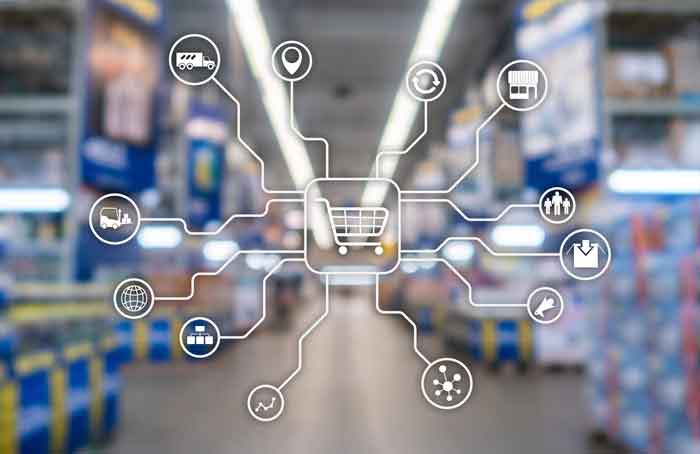With the development of digitisation, consumer behaviour is changing. Adopting an omnichannel strategy is the only way to adapt to these new behaviours, even if it implies a financial and human investment to implement an adapted strategy.
In this crisis period, retail has been hit hard by health measures, and behavioural changes have been even more sudden. Omnichannel can no longer be considered in the distant future; it is more relevant than ever to get through the crisis.
The advantages of an omnichannel strategy in retail
Omnichannel aims firstly to optimise the purchasing journey by offering a fluid and continuous customer experience – whatever the commercial channel used – and secondly to centralise and analyse all the data constituting this purchasing journey to improve it.
What are the key issues?
With the opening of shops deemed essential and closing of those considered non-essential, the decision to close small shops and to keep open supermarkets, and then the closing of shopping centres due to their size, the fluidity of the customer journey in retail has been undermined and consumers lost. They have had to rethink their habits, adapt, and look elsewhere for what they were unable to get locally. It is difficult to maintain a fluid customer relationship in these conditions, hence the need for companies to turn to omnichannel, which covers all eventualities and ensures a continuous customer relationship from social media sites to the website via click and collect.
Moreover, by collecting the data forming the customer relationship, omnichannel also serves three essential purposes: identifying the target customer, adapting to their expectations and providing a personalised offer. According to the infographic “Key figures for Customer Marketing 2020” published by customer marketing agency Kiss the Bride, personalising the customer experience improves brand image and loyalty by 40% according to the perception of customers surveyed. If omnichannel is now the ultimate weapon for personalising your commercial offer, can we still afford not to use it?
In times of crisis, customer relations take precedence
Three major post-Covid challenges are proximity (34%), simplification of the customer journey (32%) and the digitisation of customer relations (32%) (INIT and AMARC-customer relations barometer: How brands have adapted to the crisis | Comarketing-News (comarketing-news.fr) -2020)
Omnichannel puts the customer relationship at the heart of the commercial strategy to create a link with the customer, maintain this link and strengthen it.
If companies don’t move towards omnichannel, omnichannel will move towards them
During the health crisis, omnichannel has allowed companies to be present on all fronts: according to the infographic “Key figures for Customer Marketing 2020” published by Kiss the Bride (kissthebride.fr), social media sites have enabled 69% of companies surveyed to maintain a relationship with the public. Similarly, according to the social media and digital trends analysis site blogdumoderateur.com and its article “10 key figures for e-commerce in the 2nd quarter of 2020-BDM” (on blogdumoderateur.com), online sales increased by 83% in the second quarter of 2020. For Thierry Chardy, co-founder of the platform Ma ville, mon shopping “My city, my shopping,” which provides platforms for businesses to sell their products on, the current context has enabled us to gain five years of digital transformation.
Click and collect has been strengthened because they respond directly to two prerogatives linked to the health situation: firstly, they have allowed sales to continue because they comply with government-imposed measures, and secondly, they place the customer at the heart of the commercial strategy by giving them the option to continue purchasing without putting their own health at risk.
Omnichannel multiplies purchasing pathways and allows for the rapid development of solutions to respond to contextual problems, making it best commercial strategy in terms of combining proximity, flexibility and reactivity to optimise customer satisfaction. If a company does not position itself from the outset for an omnichannel strategy, it will be forced to do so. By anticipating the inevitable, it ensures better control over its human and financial investment.
With omnichannel, customer relations go further
Omnichannel allows companies to maintain a close relationship with customers. Normally, it promotes the dissemination of targeted or geolocated commercial offers to meet customer expectations as effectively as possible. In times of crisis, some companies have put omnichannel to good use by activating other loyalty levers to reinvent themselves in an unprecedented context. For instance, they may share experiences on social media, distribute gift codes for online activities, or create a videoconference purchasing service with call and collect.
“Data,” the key word in omnichannel
To make the best use of omnichannel, it is essential to collect and analyse consumer data. It is this data that will enable the best commercial channels to be activated according to the resources available to a company and its activity.
An anxiety-inducing context changes customer profiles
The more information a company has to identify changes in behaviour, the more able it is to provide an appropriate response. In times of crisis, changes in behaviour are unpredictable. An anxiety-provoking context fosters a versatile customer response. Some consumer profiles will limit their spending for fear of the future, while others will fall back on shopping to deal with their stress. We have seen food shelves and disinfectant products emptied in a matter of hours.
Omnichannel aims to better identify each consumer profile to provide a personalised solution and stimulate purchase intention. It is therefore a valuable strategy in times of crisis.
How do you collect data?
It is important to distinguish two types of data. Reporting data is obtained through customer questionnaires, satisfaction surveys or generic open-access surveys. This data promotes the possibility of providing a personalised response, especially when it comes to proprietary reporting data. Customer feedback is essential for a company to adapt its offer and its commercial channels. According to a survey published by the customer interaction management platform Critizr, 41% of French retailers have modified their customer satisfaction surveys following the Covid-19 crisis and 80% of them have observed an impact on customer loyalty following the changes.
The second source of data concerns online data. This has to do with all the entry and exit points of the customer experience, the time spent on a company’s website and the number of positive responses to promotional posts on social media etc. To optimise the analysis of this data, it is important to centralise the information as much as possible as part of CRM.
Since data is crucial to optimise an omnichannel business strategy, it is essential to invest as much in data marketing tools that will help strengthen personalisation opportunities as in measurement and data analysis tools to keep aiming for continuous improvement. According to the infographic published by Kiss the Bride, under 30% of marketers collect data across all channels to provide an omnichannel experience to their customers.
Rethinking sales compensation in the face of omnichannel
“The incentive component should no longer concern the products sold by the advisor, but the purchasing possibilities and actions created for the customer” – Ronan Yhuel, Finanpole, 2020.
Omnichannel encourages us to reinvent the incentive compensation of sales staff. There are several avenues open to companies wishing to make omnichannel a performance lever, both individually and collectively.
Valuing the performance of the salesperson regardless of their involvement in the sales process
A company can decide to allocate incentive compensation to a salesperson based on collective performance rather than individual performance. As such, whether or not the salesperson was involved in the sale, they will automatically receive a percentage of incentive compensation calculated from the overall sales of their team or BU or even the company itself.
In another way, a company can encourage collective performance by remunerating its sales staff on the basis of geographical criteria. Thus, instead of rewarding the individual performance of each salesperson, the incentive compensation of salespeople is calculated based on the collective performance of the same geographical sector. This calculation method improves team cohesion and avoids direct competition between different sales channels.
Taking into account the different entry points of customer relations when calculating incentive compensation
Instead of basing itself on the number of sales and the resultant turnover, a company can choose to calculate the variable component for the various entry points that have made it possible to convert a lead. The goal is then to provide remuneration for the actions which made it possible to materialise a sale rather than the sale itself.
For this to work, the customer relationship needs to be monitored continuously regardless of the sales channel with a CRM system which centralises all the information.
Finally, rethinking the incentive compensation of sales representatives involves defining new remuneration indicators.
Thanks to adapted CRM, it is now possible to go further and define new incentive compensation indicators such as customer engagement or customer satisfaction, the common thread of an omnichannel sales strategy.
In 2021, incentive compensation no longer rewards a sales representative for an isolated act of sale, but instead rewards their ability to maintain good levels of customer satisfaction. Encouraging them to prioritise customer needs over their own interests and taking into account the challenges of omnichannel, incentive compensation rewards the work of each person at each stage of the customer journey, regardless of the sales channel used.




